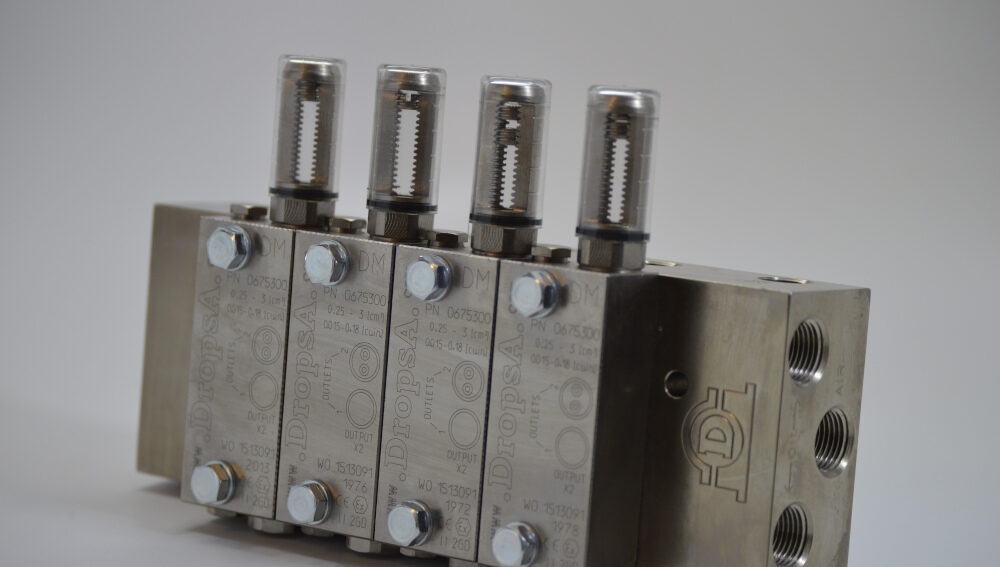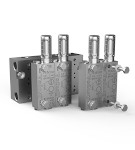

A dual-line lubrication system provides controlled lubrication doses to specific machines and equipment locations. It is called dual-line because it features two lines that disperse lubrication. Should an injector or line be blocked by an obstruction, the system can reroute the lubrication through the other line.
Many industries, including steel manufacturing, cargo handling, and food and beverage, rely on dual-line systems to keep their machinery working. Without adequate lubrication, excessive friction between surfaces, subcomponent parts, and integrated assemblies would lead to fractures, cracks, and breaks. Eventually, catastrophic failure occurs, leading to extended machine or equipment downtime and substantial repair and replacement costs.
How Dual-Line Systems Operate
A dual-line grease or oil lubrication system operates differently compared to other automatic lubrication systems, including multi-point, single-line progressive, and single-line parallel.
A dual-line system has one high-pressure pump that feeds lubricants through two lines. These two lines are responsible for dispersing lubrication to multiple points (injectors) within the system.
The pump in a dual-line system also has a controller that initiates various lubrication cycles. The pump generates pressure in the first line. At the same time, the system releases air through the second line. The venting of the second line creates the necessary pressure in the first line so that the oil or grease is delivered through the tubes to half of the system’s lubrication injectors. The other half of the injectors are reserved for the second line.
The pressure built up in the first line is monitored through a switch monitor. Once the lubrication is delivered throughout the first line, the monitor initiates a changeover to the second line through a changeover valve. At this point, the first line is vented, and the second line builds up the necessary pressure to deliver lubricant to the remaining injectors.
Advantages
One of the direct benefits of dual-line systems is that any given obstruction or issue with one of the lines won’t stop the lubrication process. The system will merely divert the lubrication to the other line through an inverter valve.
Next, these systems deliver precise lubrication because pressure switches monitor and control the end-of-line pressure. This means the system can instantaneously adjust to any issue with a line experiencing low pressure. And continuously delivering precise lubrication helps prevent machinery downtime and expensive repairs.
Lastly, these systems can deliver metered amounts of lubricants over several hundred feet and multiple lubrication points, making them very flexible and adaptable.
Overall Benefits:
- Continuous Lubrication: A dual-line system will continuously disperse lubricants to multiple locations even if one line is blocked.
- Accuracy: A dual-line system can consistently disperse specific amounts of lubricant to various points, which prevents common errors and risks associated with manual lubrication.
- Reduces Machine Downtime: All industrial machinery needs continuous lubrication to prevent bearing failure and reduce general wear and tear. Because dual-line systems deliver continuous, precise lubrication, the lifecycles of machinery and equipment are extended.
Suitable Lubricants
The lubricants that work best with a dual-line lubrication system include oil, fluid grease, and grease.
The International Standards Organization (ISO VG) classifies the viscosity grades of oils from 2 to 3200, while the National Lubricating Grease Institute (NLGI) classifies fluid grades as grades 000, 00, 0, and greases as 1, 2, 3, 4, 5, and 6.
Grease are lubricants that consist of oil, performance-enhancing additives, and thickening agents. The best greases for dual-line systems include any greases with an NLGI rating of 1 to 3. However, before companies purchase lubricants, they should verify which particular oil, semi-fluid grease, or grease the system’s manufacturer recommends.
Learn More About Dual-Line Lubrication Systems Today
Do you have questions about dual-line lubrication systems? Reach out to our experts at DropsA. Founded in 1946, we’re an ISO-certified manufacturer, designer, and supplier of automatic lubrication systems and accessories. You can view our products and solutions in our online catalog. If you need help selecting the right lubrication solution for your application or want to learn more about dual-line systems, contact us today to speak with one of our team members.
